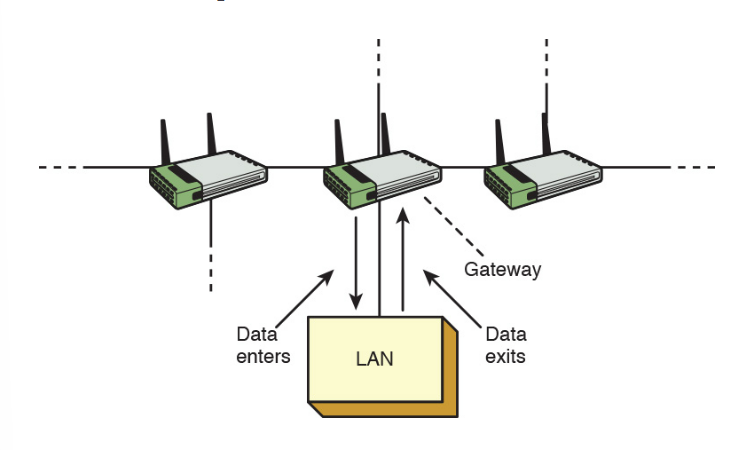Chapter 8.2 Reading: Routing Fundamentals - Hsanokklis/2022-2023-Tech-journal GitHub Wiki
Summary: This section further defines the function of a router in a network and describes how data packets travel through a layer 3 network. A layer 3 network uses IP addressing for routing data packets to the final destination. Delivery of the data packets is made possible by the use of a destination MAC address, IP address, network addresses, and routing tables. Each of these concepts is examined in this section.
LANs
- LANs are not restricted in size, they can have 20, 200 or more computers
- Multiple LANs can be connected to create a large LAN
- EX. First floor could be one LAN, second floor another, third floor another. They can all be connected to make one big LAN using switches.

- The number of computers connected to a LAN can affect network performance. It becomes an issue because layer 2 switches do not by default separate Broadcast Domains. Meaning any broadcast will be sent out to all computers on the LAN, and each computer needs to determine whether to respond or not. This will slow down the computer and the network.

- VLANs are being used to interconnect LANs.
- a network with multiple LANs interconnected at layer 2 is called a Flat Network.

-
Using a flat network should be avoided when possible since network time is greatly affected.
-
The solution for breaking up the broadcast domains and providing network routing is to incorporate routing hardware into the network design to create a Routing Network

- In layer 3 networks, routers and layer 3 switches are used to interconnect LANs and other networks in order to isolate broadcast domains.

-
the Default Gateway is the IP address of a networking device used to forward data that needs to exit the LAN.
-
in most networks the gateway is a router or switch port.

- A routing table is a list of the possible networks that can be used to route the data packets. Alternative data paths are usually provided so a new route can be selected and data delivery can be maintained even if a network route is down.

-
The MAC address is used to define the hardware address of the next hope in the network. When the hop is defined, the MAC address is determined and the data packet is relayed.
-
When the routes are fully configured, data packets can be exchanged between any LANs in the interconnected routed network.
-
Network addresses are used when configuring the routers and defending which networks are connected to the router.
-
Network segment address such as 10.10.20.0. All hosts in the 10.10.20.0. NET will have the 10.10.20.# IP address.
-
subnet mask is used to determine whether the data is to stay in the LAN or should be forwarded to the default gateway provided by the router.

Conclusion:
The subnet mask is used to determine whether the data is to stay in the LAN or is to be forwarded to the default gateway provided by the router. The router uses its subnet mask to determine the destination network address. The destination network address is checked with the router’s routing table to select the best route to the destination. The data is then forwarded to the next router, which is the next hop address. The next router examines the data packet, determines the destination network address, checks its routing table, and then forwards the data to the next hop. If the destination network is directly connected to the router, it issues an ARP request to determine the MAC address of the destination host. Final delivery is then accomplished by forwarding the data using the destination host computer’s MAC address. Routing of the data through the networks is at layer 3, and the final delivery of data in the network is at layer 2.